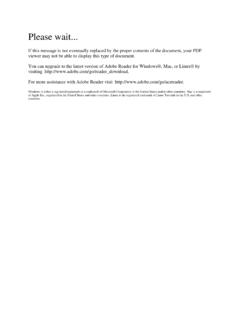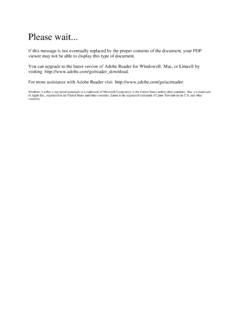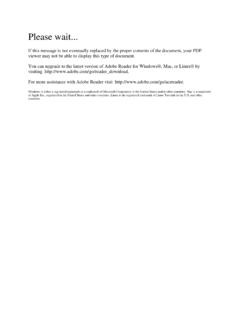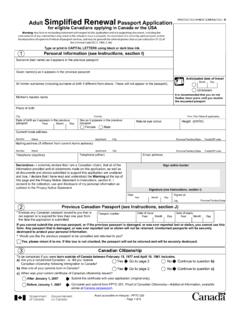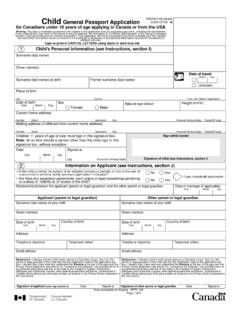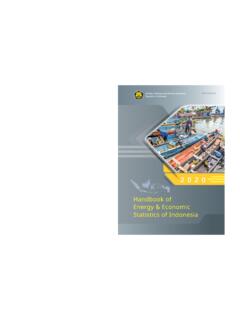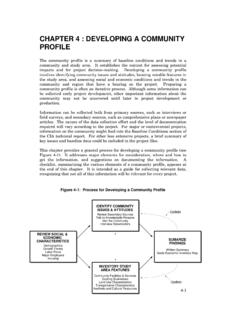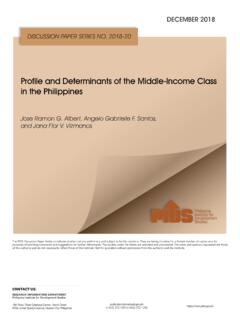Transcription of POVERTY PROFILE: SPECIAL EDITION - Canada
1 In two of Canada s largest cities, more than half of all persons living in POVERTY were from racialized groups: 58% in Vancouver; and 62% in do we mean by the term racialized persons?We use this term to mean persons, other than Aboriginal peoples, who are non-Caucasian in race or non-white in colour. In this bulletin, the term racialized persons refers to those people who self-described as a visible minority on the 2006 Census. For more information about terminology, refer to the Methodology section at the end of the OUTCOMESP overty in racialized communities is a growing problem.
2 For example, in Toronto, the number of racialized families living in POVERTY increased 362% between 1980 and 2000, far greater than their population growth of 219%.1 The problem is especially severe among more recent immigrants, the vast majority of whom belong to racialized groups. In general, over the past two decades POVERTY rates have been rising among immigrants and falling among the1 United Way of Toronto and the Canadian Council on Social Development. POVERTY by Postal Code: The Geography of Neighbourhood POVERTY , 1981-2001. Toronto: United Way of Toronto, April COUNCIL OF WELFARE REPORTSPOVERTY profile : SPECIAL EDITIONA SNAPSHOT OF RACIALIZED POVERTY IN CANADAH ighlightsHighlightsCompared to non-racialized persons living Compared to non-racialized persons living in POVERTY , racialized persons living in POVERTY in POVERTY , racialized persons living in POVERTY are more likely to be:are more likely to be.
3 Youngyoung married married immigrantsimmigrants highly educated, andhighly educated, and their incomes are lower than non-racialized Overall their incomes are lower than non-racialized persons living in POVERTY . But, when they work full persons living in POVERTY . But, when they work full year in a full-time job, their employment incomes year in a full-time job, their employment incomes are higher than their non-racialized higher than their non-racialized CANADIANS HAVE A GREATER RISK OF LIVING IN POVERTYR acialized communities face high levels of POVERTY .
4 The 2006 Census showed that the overall POVERTY rate in Canada was 11%. But for racialized persons it was 22%, compared to 9% for non-racialized the racialized community, POVERTY rates varied widely, from a high of 40% for those who identified as Korean to a low of 11% for those who identified as | NCW | POVERTY profile : SPECIAL EDITION Canadian This goes hand in hand with the steep decline in the relative earnings of immigrants over that time period. The decline occurred even though education levels were rising among immigrants. One study estimated that by the late 1990s, 41% of chronically poor immigrants had S SPECIAL ABOUT THIS BULLETIN?
5 A statistical profile of people living in povertyWhen we looked for statistical information about the racialized community in Canada , we found many demographic and socio - economic we did not find was profiles that focused only on people living in POVERTY . To fill this gap, we created a snapshot of the demographic and socio - economic characteristics of racialized people living in POVERTY in Canada . We used 2006 census data to create the profile . We also looked at differences between this group and non-racialized persons living in POVERTY . Limits to the profileFirst, this profile is an overview of all racialized persons living in POVERTY .
6 It does not look at specific racialized groups. We recognize that there is great diversity within the racialized community that is not captured in this overview. Second, many of the factors that make up this snapshot are co-dependent. For example, language ability can affect employability. These relationships can be lost when looking at each 2 Picot, Garnett and Feng Hou. The rise in low income rates among immigrants in Canada . Statistics Canada Catalogue no. 11F0019 MIE2003198, June Picot, Garnett, Feng Hou and Simon Coulombe. Chronic Low Income and Low-income Dynamics Among Recent Immigrants.
7 Statistics Canada Catalogue no. 11F0019 MIE2007294, January individually. We encourage readers to step back from any particular issue and consider the big , the reasons for the differences we found between racialized and non-racialized persons living in POVERTY are beyond the scope of this statistical profile . Readers interested in the why may wish to use our list of selected readings at the end of the bulletin to further explore this IN THREE PROVINCEST here were million racialized persons living in POVERTY in Canada in 2006. They made up: 4% of the total population 22% of all racialized persons 32% of all persons living in over half (52%) lived in Ontario, followed by British Columbia (20%) and Quebec (18%).
8 Toronto was home to 41% of all racialized persons living in POVERTY . Vancouver was a distant second, with 18%, followed by Montreal at 17%. Together, these three cities were home to 76% of racialized persons living in | POVERTY profile : SPECIAL EDITION | 3 Different geographic distribution for non-racialized personsThe million non-racialized persons living in POVERTY were not as heavily concentrated in Ontario. About a third (32%) lived in Ontario, followed by Quebec (30%) and British Columbia (13%).By city, 16% of poor non-racialized persons lived in Montreal, followed by Toronto (11%) and Vancouver (6%).
9 This totals to 34%, a far cry from the 76% of poor racialized persons living in these three THE profile IN CONTEXTThis profile focuses on racialized persons living in POVERTY . Many of the results reflect the overall make-up of the entire racialized population of Canada . For example, overall the racialized population is relatively young. It is no surprise, then, that the racialized population living in POVERTY is also young. Here are some key statistics about the racialized population in Canada , according to the 2006 population: The racialized population is growing at a faster rate than the non-racialized population.
10 By 2031, it is projected that about one Canadian in three could belong to a racialized group, up from one in 20 in Geographically concentrated: More than half (54%) of the racialized population lives in Ontario, followed by British Columbia (20%), Quebec (13%) and Alberta (9%). Toronto is home to 43% of all racialized persons in young: Thirty-eight percent of the racialized population is under 25 years old, compared to 30% of the non-racialized live with family members: Only 8% of racialized persons do not live with any family members, compared to 15% of non-racialized are immigrants: Two-thirds of racialized persons are immigrants, with the majority coming from countries in Asia.
